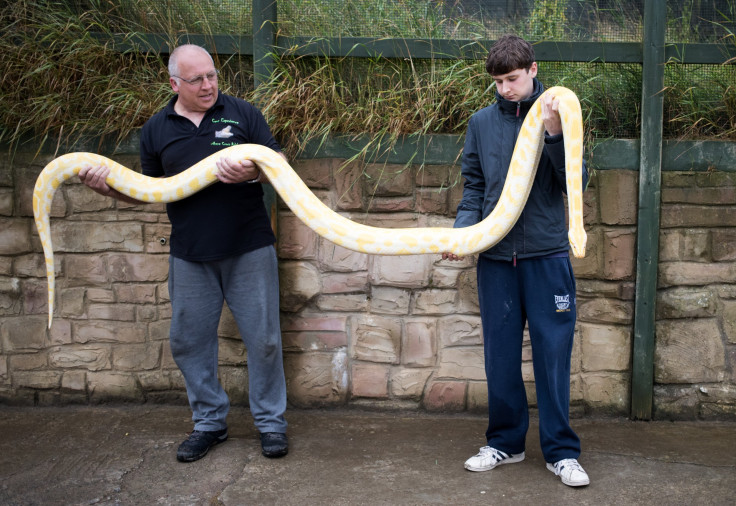15-Foot Albino Python Found Dead In Texas, Could Have Been Someone's Pet

It was a pit bull climbing a tree a few weeks ago and this time it is a snake. The Animal Control officers have been on their toes discovering something interesting all the time. The officers in the Dallas suburb of DeSoto, Texas, found a giant albino Burmese python Saturday.
The 15-feet long Burmese python was found near the 1300 block of Plaza Road, near Interstate 35 East and East Pleasant Run road. When the animal control officers found the snake, it was already dead.
The DeSoto Police Department on Monday posted pictures of the dead python on their Facebook page. According to a report in ABC 13, the officers claimed that the snake seemed to have had a big lunch before its death.
See posts, photos and more on Facebook.
However, it wasn’t clear if the reptile was somebody's pet and how it reached the location.
A Burmese python is a non-venomous reptile which is known to be one of the five largest species of the snakes in the world.
The National Geographic described the snake to be docile, which makes it a good choice for pet owners. These snakes with beautifully patterned skin have a very high growth rate.
These pythons are captive-bred for color, pattern, and size. The albino form of the Burmese python is very popular and is found in abundance. They are usually white with patterns in butterscotch yellow and burnt orange but some of them are of different colors like – green and granite. These pythons are generally sold as pets because of their attractive color and easy-going nature.
Although these pythons are afraid and generally avoid human contact, yet they must be handled cautiously as they can cause death if mishandled. These pythons are not poisonous but can coil around and kill a person.
The Burmese pythons are carnivorous in nature and primarily eat birds and mammals. Using their sharp teeth these snakes grab their prey and coils around, killing the prey by constriction. When these snakes are in human habitation, they usually feed on rats and rabbits. They also look for pigs and goats. However, the giant pythons look for larger preys like alligators and deer.
According to the National Geographic, the Burmese pythons can be up to 23 feet long or even more. They can weigh up to 200 pounds. However, according to a report in the Sun, these pythons are usually up to 12.1ft-long but some of them have grown up to 18.8ft. The female pythons are heavier, bulkier, and little longer as compared to their male counterparts.
These snakes, when they are small spend more time in the trees but as they grow they start living more on the ground. They are also excellent swimmers and can stay submerged for up to 30 minutes.
The Burmese pythons have a lifespan of nearly 25 years. They usually breed in the early spring, with females laying clutches of 12–36 eggs in March or April. Until the time the eggs do not hatch, these snakes stay with their eggs, coiling around them and twitching their muscles to keep the eggs warm.
© Copyright IBTimes 2024. All rights reserved.





















